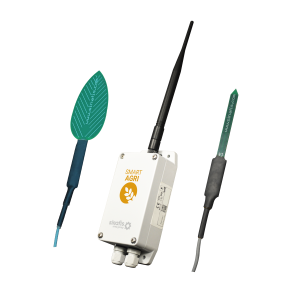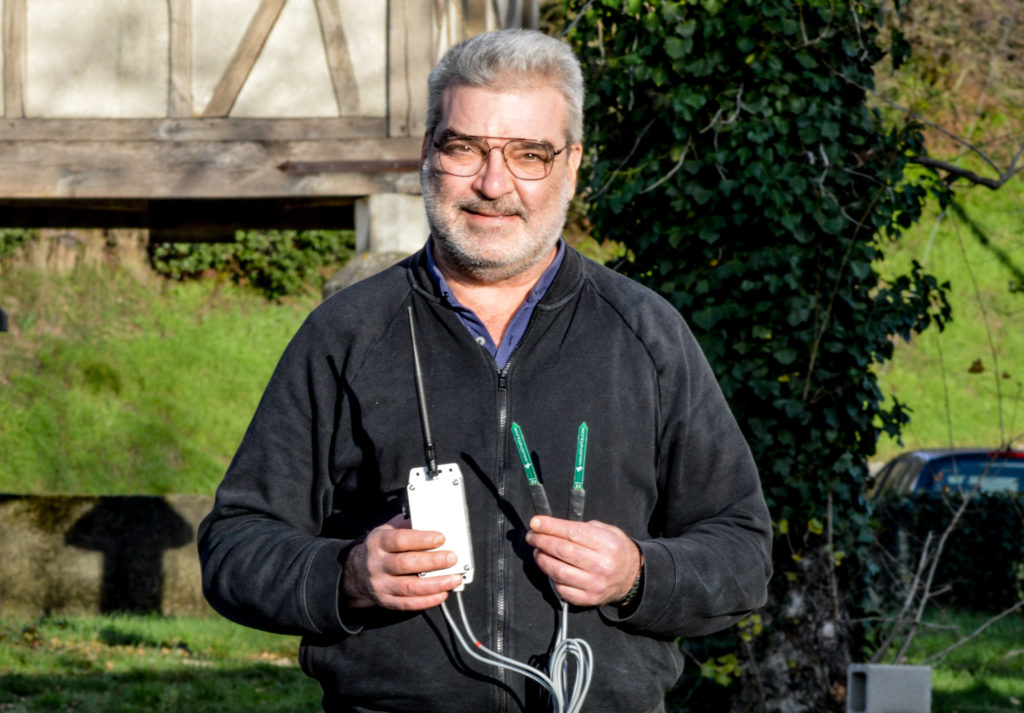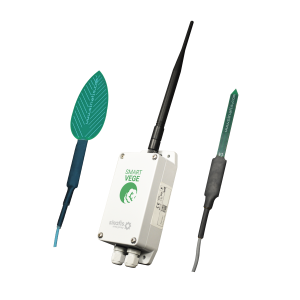
Sensor systemsSmartAROMAWhy deploy this system for the production of medicinal and aromatic plants? To measure the level of leaf humectation To anticipate diseases linked to the persistent presence of humidity on the leaves and reduce the usage of phyto-sanitary treatments. To measure soil temperature and humidity at two different depths To monitor root-level humidity during the […]

Capacitive Sensors for Medicinal and Aromatic plants
Used by aromatic and medicinal plant growers, the SmartAROMA solution, developed by Sinafis, is a complete kit of robust and precise measurement tools. The system collects data using capacitive hygrometric sensors that monitor the soil, air and leaf conditions of aromatic and medicinal plants.
Complete systems from
€ 424.00
Why deploy this system for the production of medicinal and aromatic plants?
To measure the level of leaf humectation
To anticipate diseases linked to the persistent presence of humidity on the leaves and reduce the usage of phyto-sanitary treatments.
To measure soil temperature and humidity at two different depths
To monitor root-level humidity during the developmental phases of the plant.
To measure the temperature and humidity of the air
To insure the proper greenhouse conditioins and anticipate pest and disease development.
What data does this all-in-one sensor system measure?
The Sensors
Leaf Humectation✅
Soil Humidity ✅
Soil Temperature ✅

In the Transmission Unit
✅ Air Humidity
✅ Air Temperature
✅ GPS Position

What does the SmartAROMA solution bring to aromatic and medicinal plant producers?
Optimization of water resources
By irrigating the aromatic and medicinal plants only when necessary.
Improving the quality and quantity of production
By anticipating known risks (diseases, pests, etc.).
Refining annual predictions by tracing the evolution of climatic cycles
By analyzing the data collected with precision.
Managing budget constraints
By equipping yourself with high-performance, low-cost technology.
How does this connected sensor system for plant production?
Ultra-local data measurements
The sensors can be placed as close as possible to the foliage or the roots of the plants to benefit from ultra-localized data.
Secure data transmission
The sensor integrates a communication module for the Sigfox network. In France, 94% of the territory is covered.
E-mail
alerts and online history
LThe Sinasens application supplied with the sensor makes it possible to configure and receive personalized alerts as well as to consult the data collected. You can also use the API to download your data in an “open data” format for integration with plot management and plant life-cycle software.
The advantages of the SmartAROMA all-in-one sensor system
Robust technology
Designed to last, the sensor system is specially designed for the production of aromatic and medicinal plants.
Mobile sensor system
Easily move the sensor to where you want it, when you want it.
Geolocated system
GPS positioning makes it possible to precisely locate the systems and also to deter theft.
Extended autonomy
The battery life is approximately 2 years and their condition is monitored to anticipate their replacement.
Simple installation
The entire system was designed to be deployed in less than 5 minutes.
French made
Sinafis products are made in France, in the Tarn in the Occitanie region.
Sensor systems tested and recommended by producers of aromatic and medicinal plants

Olivier Plessis
Producer in the Tarn-et-Garonne (82)
Olivier Plessis has considerably reduced his water consumption, and at the same time diseases due to excess humidity, thanks to the data collected by his SmartAROMA sensors.
I was very quickly won over by this product and its advantages for better irrigation management, a crucial element for vegetable farming. Watering, although essential, takes a long time for vegetable farmers, and the lack or the excess of water can be fatal for the whole culture.
Behind the technology, a specialized service for producers of aromatic and medicinal plants
? Financing
We advise you on the aids and subsidies that you can obtain for the acquisition of this sensor system for aromatic and medicinal plants.
? Installation and activation
We are ready to assist you remotely on the implementation of the system for your plants.
? Video training
Choosing Sinafis means having access to free resources and tutorials to make the best use of our solution for your plants.
? Purchase or lease
The solution is available for purchase or lease, in order to best adapt to your needs in the short and long term.
Frequently asked questions
Yes, as precision equipment, this sensor is eligible in 2021 for State funding from the FranceAgriMer recovery plan for a minimum order amount of € 2,000 (group purchase included). More information on the website: www.franceagrimer.fr
The number of sensors to install depends on the slope and the type of soil of your plot and not on its surface. For a sloping plot, it is better to deploy 2 sensors: one at the top of the slope and one at the bottom of the slope. For greenhouses, it is one system per type of plant. Contact us to help you decide.
The battery life of the system depends on the frequency of the data transmission. The lifespan is up to 3 years with a frequency of one transmission per day. With a frequency of 6-12 transmissions per day, the autonomy is approximately one year.
Yes, the Sinasens application is available on your computer but also accessible from your web browser on a smartphone or tablet, at the same address.





